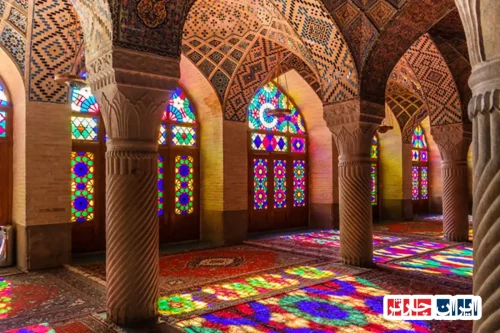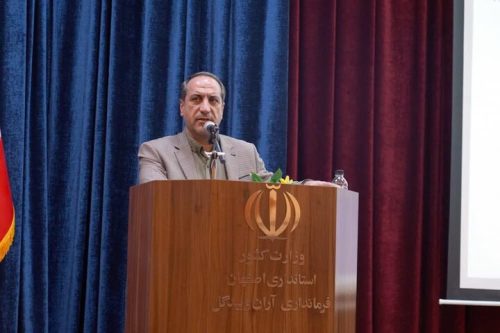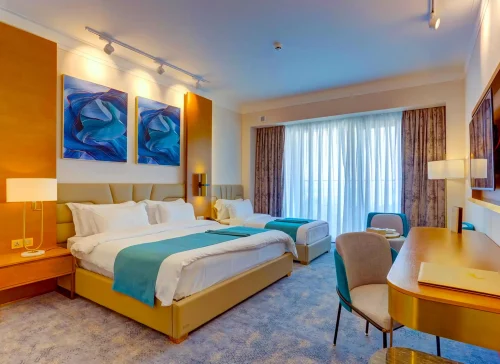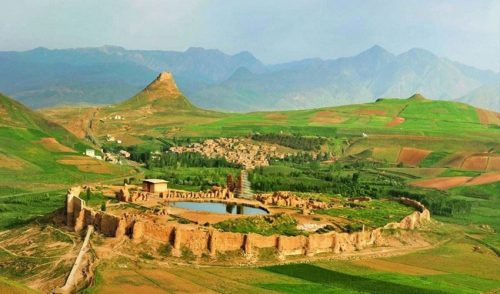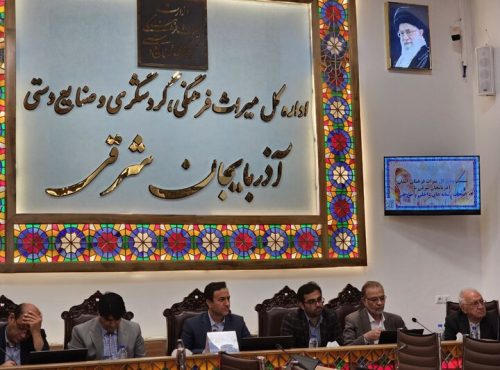News Source : https://www.irna.ir/news/85645532/%D8%A8%D8%B1%D9%86%D8%A7%D9%85%D9%87-%D8%B1%DB%8C%D8%B2%DB%8C-%D8%A8%D8%B1%D8%A7%DB%8C-%D8%AD%D8%B6%D9%88%D8%B1-%D9%85%DB%8C%D8%AF%D8%A7%D9%86%DB%8C-%D9%86%D9%85%D8%A7%DB%8C%D9%86%D8%AF%DA%AF%D8%A7%D9%86-%D9%85%D8%AC%D9%84%D8%B3-%D8%AF%D8%B1-%D8%A7%D9%85%D8%A7%DA%A9%D9%86-%D8%AA%D8%A7%D8%B1%DB%8C%D8%AE%DB%8C
Planning for Field Presence of Parliament Representatives in Historical Sites
Yazd, IRNA – CEO of the Fund for Development and Revival of Historical Sites stated that planning for the presence of representatives in historical buildings aims to experience the capacities, achievements, and existing barriers. According to IRNA, Shahab Talaei Shakari elaborated on the fund’s activities in the country at a meeting with members of the Councils Commission and Internal Affairs of the Parliament in Yazd. He added that this fund symbolizes the Leader’s New Year message and the realization of public participation in the preservation, restoration, revival, and operation of historical buildings. He presented statistics on the process of handing over historical buildings and mentioned how parliamentary cooperation in removing certain barriers can lead to the revival and operation of many governmental and public historical buildings.
Mohammad Saleh Jokar, Head of the Councils and Internal Affairs Commission of the Islamic Consultative Assembly, also described the role of the Ministry of Cultural Heritage Development and Restoration Fund in reviving historical buildings as important and stated that the commission will spare no effort in reviving the country’s historical capacities. He added that by reviving many historical buildings, we can not only preserve the cultural identity but also create employment and boost tourism. Jokar added that historical texture and buildings are an opportunity for identity-based development and should be properly utilized. Members of the Councils Commission and Internal Affairs of the Islamic Consultative Assembly arrived in Yazd province last night. According to the Public Relations and International Affairs of the Development and Revival Fund, this trip, hosted by the Ministry of Cultural Heritage Development and Restoration Fund, aimed at a field visit to the fund’s activities in restoring and operating historical buildings in the world heritage city of Yazd. Previously, the Development and Revival Fund in Ardabil Province hosted members of the Cultural Commission of the Parliament.
Objectives of Planning for Field Presence of Parliament Members in Historical Sites
Planning for the field presence of parliament members in historical sites aims to enhance understanding and appreciation of the country’s cultural and historical values. These field visits allow members to directly acquaint themselves with the current condition of historical buildings and identify their preservation and revitalization needs. Moreover, this activity strengthens the relationship between parliament and the Ministry of Cultural Heritage, facilitating effective decision-making regarding the protection of historical sites.
The Role of Council and Internal Affairs Commission Members in Revitalizing Historical Buildings
Members of the Council and Internal Affairs Commission of the Islamic Consultative Assembly play a significant role in supervising and guiding the revitalization of historical buildings. Through thorough examination of each historical building’s status, they ensure the allocation of necessary financial and human resources for their preservation and restoration. Close collaboration between the commission and the Historical Sites Development and Revitalization Fund guarantees the achievement of revitalization plans’ goals and the preservation of the country’s cultural heritage.
The Impact of Field Planning on Enhancing the Capabilities of Historical Buildings
The field presence of parliament members in historical sites significantly enhances these sites’ capabilities. Through such visits, members can identify buildings’ real needs and propose improvements in facilities and increased visitor numbers. Additionally, these field reports can serve as a basis for formulating effective policies regarding the development and utilization of historical sites.
Challenges and Obstacles in Utilizing Historical Sites
Utilizing historical sites faces challenges and obstacles that require comprehensive and effective solutions. A major obstacle is the lack of financial and human resources, which can slow down the process of restoration and revitalization. Furthermore, public ignorance regarding the importance of these sites and lack of legal support are other existing challenges. With precise planning and cooperation among various bodies, these obstacles can be overcome, ensuring optimal utilization of historical sites.
Collaboration with the Historical Sites Development and Revitalization Fund
The Historical Sites Development and Revitalization Fund acts as a crucial institution in the process of revitalizing historical buildings. This fund provides financial and technical resources, enabling the restoration and preservation of buildings. Close cooperation between parliament members and this fund should be based on synergy and information exchange, facilitating the adoption of optimal solutions for preserving the country’s cultural heritage. Additionally, parliament members can improve the fund’s performance by facilitating certain processes and removing legal obstacles.
Public Participation in the Preservation and Restoration of Historical Buildings
Public participation is a key factor in the success of planning for parliament members’ field presence in historical sites. Attracting support and involvement from the local community and cultural heritage enthusiasts can strengthen the process of restoration and preservation of buildings. Through awareness programs and encouraging active participation, social responsibility for preserving historical sites can be increased, thereby providing the necessary resources for completing revitalization projects.
The Impact of Revitalizing Historical Buildings on Employment and Tourism
Revitalizing historical buildings has a direct impact on creating jobs and boosting tourism in various regions. By renovating and restoring buildings, job opportunities in fields such as architecture, tourism, and related services are created. Moreover, increased attractiveness of historical sites can draw in both domestic and foreign tourists, boosting financial revenues. This process significantly aids the economic development of historical areas and the preservation of their cultural identity.
The Process of Transferring Historical Buildings to the Public and Governmental Sectors
The process of transferring historical buildings to public and governmental sectors requires a careful balance between cultural heritage preservation and optimal utilization. Public transfer can be effective in preserving and maintaining buildings through volunteer efforts and community projects. Meanwhile, the role of governmental bodies in regulating laws and providing financial and technical support is crucial for ensuring these buildings’ preservation. This collaboration between the public and government can lead to the sustainable management of historical buildings.
Future Plans for Revitalizing Historical Fabrics in Yazd Province
Yazd Province, with a large number of historical buildings, requires forward-looking plans for historical fabric revitalization. Planning for the field presence of parliament members can help identify the needs and revitalization priorities, providing pathways for executing preservation and development projects. Additionally, creating comprehensive plans that include local community participation and utilize modern technology in the restoration process can enhance the effectiveness of future programs and promote Yazd Province as an attractive historical tourism destination.
The Importance of Preserving Cultural Identity through Revitalizing Historical Sites
Preserving cultural identity is one of the main objectives of planning for parliament members’ field presence in historical sites. Historical buildings are recognized not only as symbols of the country’s history and culture but also as bearers of social and artistic values. Through preserving and revitalizing these buildings, national identity is strengthened, allowing future generations to connect with their culture and history. This leads not only to national pride but also contributes to enhancing self-esteem and social cohesion.
Frequently Asked Questions
- What actions does the Historical Sites Development and Revitalization Fund’s planning include?
- The Historical Sites Development and Revitalization Fund’s planning includes organizing field visits of representatives to historical buildings to experience the capacities, achievements, and existing challenges firsthand.
- What is the purpose of parliament members’ field presence in historical buildings?
- The purpose of parliament members’ field presence in historical buildings is to examine the capacities, achievements, and existing challenges for the revitalization and utilization of these sites.
- What is the role of the Development and Revitalization Fund in preserving historical buildings?
- The Development and Revitalization Fund symbolizes the Leader’s New Year message and the realization of public participation in preserving, restoring, revitalizing, and utilizing historical buildings, playing a significant role in reviving the country’s historical capacities.
- How can cooperation with the Islamic Consultative Assembly remove obstacles to historical buildings’ revitalization?
- Through cooperation with the Islamic Consultative Assembly and removing certain barriers, many historical buildings of governmental and public ownership can be revitalized and utilized.
- What are the Development and Revitalization Fund’s plans for attracting public investments?
- The Development and Revitalization Fund, through providing statistics and the process of transferring historical buildings, offers plans to increase public participation in revitalizing historical sites.
- How can revitalizing historical buildings help preserve cultural identity?
- Revitalizing historical buildings helps preserve cultural identity by maintaining and restoring these sites, thus preserving and strengthening the community’s cultural identity.
- What is the impact of revitalizing historical buildings on job creation and tourism growth?
- Revitalizing historical buildings not only preserves cultural identity but also facilitates job creation and tourism growth, leading to regional economic development.
- How does Mohammad-Saleh Jokar, the head of the Council and Internal Affairs Commission, evaluate the fund’s role?
- Mohammad-Saleh Jokar described the role of the Development and Revitalization Fund of the Ministry of Cultural Heritage as very important in revitalizing historical buildings and stated that this commission will spare no effort in revitalizing the country’s historical capacities.
- What were the objectives of the Council and Internal Affairs Commission members’ visit to Yazd Province?
- The objective of the Council and Internal Affairs Commission members’ visit to Yazd Province was to conduct field visits to the activities of the Development and Revitalization Fund in revitalizing and utilizing historical buildings in the World Heritage City of Yazd.
- What actions has the Development and Revitalization Fund taken in various provinces of Iran?
- The Development and Revitalization Fund in Ardabil Province also hosted cultural commission members from the parliament and conducted similar activities in revitalizing historical buildings.
- What does the historical building of the Leader symbolize?
- The historical building of the Leader symbolizes the New Year message and the realization of public participation in preserving, restoring, revitalizing, and utilizing historical buildings.
- What are the activities of the Development and Revitalization Fund in the World Heritage City of Yazd?
- The activities of the Development and Revitalization Fund in the World Heritage City of Yazd include field visits to historical buildings, examining the transfer process, and attracting public investments for revitalizing and utilizing these sites.
- How does planning for field presence help overcome existing challenges?
- Planning for field presence provides parliament members with the opportunity to experience capacities, achievements, and identify existing obstacles, which can be effective in overcoming challenges.
- What statistics did Shahab Talaie Shokri present?
- In a meeting with members of the Council and Internal Affairs Commission, Shahab Talaie Shokri presented statistics on the process of transferring historical buildings and attracting public investments.
- How do public associations contribute to the revitalization of historical buildings?
- Public associations, by investing and participating in projects for revitalizing historical buildings, play an important role in preserving and utilizing these sites.
- What obstacles exist in the revitalization of historical buildings that need addressing by the Islamic Consultative Assembly?
- Obstacles such as strict regulations, lack of financial resources, and bureaucratic inefficiencies prevent the revitalization of historical buildings and need addressing by the Islamic Consultative Assembly.

